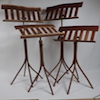What are good methods for setting up a jointer? Where I've placed my jointer works well for shop flow, and up until yesterday it used to be about 1ft over such that one pedestal was over the joint of concrete. It seemed to slowly shift/settle because every several months I've had to realign the beds. So I moved it to where it is in these photos, but then it had such wobble due to non-flat concrete, I had to shim it. I'm wondering what options I have to stabilize it, or am I chasing a ghost due to the movement of concrete? Where is now, should it be ok?
I'm seeing the benefits of the 3-legged Porter machines.
IMG_9006.jpg
IMG_9002.jpg
IMG_9005.jpg





 Reply With Quote
Reply With Quote






